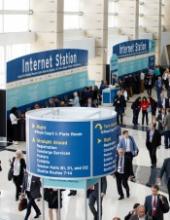Large MM trial finds denosumab non-inferior to ZA for SRE
CHICAGO—The largest international multiple myeloma (MM) trial ever conducted, according to the trial sponsor, met its primary endpoint, demonstrating that denosumab is non-inferior to zoledronic acid (ZA) in delaying the time to first on-study skeletal-related event (SRE) in patients with MM.
In addition to bone-specific benefits, denosumab-treated patients had significantly fewer renal adverse events and possible prolongation of progression-free survival.
Denosumab “may in fact be a new standard of care for multiple myeloma-related bone disease,” according to one of the investigators.
“The other important thing to note,” Noopur S. Raje, MD, said during her presentation at the ASCO 2017 Annual Meeting, “is denosumab can be administered despite renal function in patients with myeloma.” It does not need to be dose-adjusted, unlike bisphosphonates.
Dr Raje, of the Massachusetts General Hospital Cancer Center in Boston, Massachusetts, presented the study results as abstract 8005.
Study design
The international, phase 3, randomized, double-blind study is evaluating the safety of denosumab compared with ZA in newly diagnosed MM patients.
Investigators enrolled 1718 patients from 259 sites and 29 countries.
They randomized 859 patients to receive denosumab 120 mg subcutaneously every 4 weeks plus intravenous placebo every 4 weeks, and 859 patients to the standard ZA dose of 4 mg intravenously plus subcutaneous placebo every 4 weeks.
Patients were stratified by whether they were on novel-based anti-myeloma therapy, whether they planned to have an autologous peripheral blood stem cell (PBSC) transplant, disease stage, and previous SRE.
“We were looking for 676 on-study SREs, and if we saw a benefit, patients would be offered open-label denosumab for up to 2 years after this,” Dr Raje said.
“Patients had to have radiographic evidence of bone disease, and this is different from some of the other bone disease studies that you’ve seen in the recent past,” she added.
In addition to documented evidence of MM, patients had to be 18 years or older, be ECOG status of 2 or better, have adequate organ function, and plan to receive or be receiving primary frontline anti-myeloma therapy.
Patients were excluded if they had nonsecretory MM, more than 30 days of previous treatment with anti-myeloma therapy prior to screening, prior use of denosumab, use of oral bisphosphonates with a cumulative dose of more than 1 year, more than 1 previous dose of intravenous bisphosphonate, or prior history or current evidence of osteonecrosis/osteomyelitis of the jaw.
The primary endpoint was time to first on-study SRE, “and the idea here was to look for non-inferiority,” Dr Raje explained.
Secondary endpoints included time to the first on-study SRE (superiority), time to the first-and-subsequent on-study SRE (superiority), and overall survival.
Investigators also included the exploratory objective of progression-free survival (PFS).
Patient demographics
Patients were well balanced across the 2 arms, Dr Raje noted, and the breakdown of myeloma disease stage at diagnosis was comparable between the ZA and denosumab arms.
About 32% of patients were stage I, 37% stage II, and 29% stage III. Stage was not available for 49 patients.
A little more than half (54%) were male, mean age was 63 years, and 82% were white.
Two thirds had prior SRE history, and 54% of patients intended to undergo autologous PBSC transplant.
Enrollment began May 2012 and continued through the end of March 2016. The primary analysis cutoff was July 19, 2016.
Results
The primary endpoint for non-inferiority for time to first on-study SRE was met by denosumab (HR=0.98, 95%CI: 0.85, 1.14; P=0.01).







